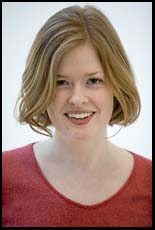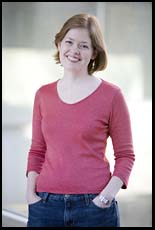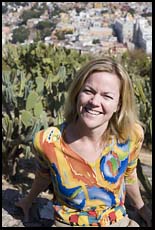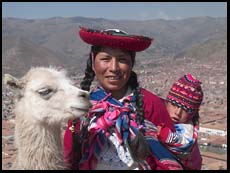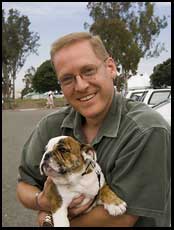Upon setting out on this task I set myself, I really enjoyed the journey as well as my results. And although it doesn't fully end here, as I don't travel to South Africa until October, I feel I've come quite a long way personally, and putting everything that I have learnt over the past two years into practice. From the beginning with my presentation and interview to get to Africa, in which I am so proud of myself for achieving, gaining confidence and great people skills, I feel the project I chose to do fit perfectly. I carried out a series of portraits of a range of people, all ages, of which I am proud of. Although struggling at first technically, I feel in further shoots I perfected the technique that I wanted to achieve with a large set of high key portraits. I don't feel I had any problems in my people skills and interacted well with my sitters to get some fantastic eye contact, emotion and creativity, which from the extensive research I carried out, taught me was so important. To make the set of images I created stronger, I got the chance to do some Becker style shots of the caravans and homes that the people's portraits I had taken lived in. When stood together look great, and a strong set of images.
I feel the composition and pattern of all of the images compliment each other well, and have a factual yet aesthetically pleasing aspect to them. Along with the fact that I used the hassleblad to shoot the images, which I feel gives them a naturally beautiful quality to them, the borders of such film framing each of the images makes them stand out and look like bold, strong images even when stood alone away from the set. Although, as you can see, look much better when presented as a large group, as intended.
I learnt a great amount of new technical skills throughout this brief, including using film which I hadn't done to any great extent before, and learning to process this film in the darkroom, along with then putting my post-production skills to use in Photoshop.
All in all I feel the journey I went on for this project, matured me and improved skills in every aspect of my work, and in myself.
South Africa, FMP
In October I have been lucky enough to be chosen to travel to South Africa to do an exhibition of my work, with the University Center at Blackburn College. This blog is to simply document my journey and work.
Portraiture tips 2
6x6: Give your subjects some room
The rectangular format of most cameras encourages photographers to crop rather tightly around a subject's face or torso. The 6x6 cm square format encourages you to give subjects a little bit of space.
 | Roommates. Sadly marred by a technical flaw: the reflector edge in the lower left corner of the frame. |
 | Reading. From Cape Cod. This was taken with the 80mm lens, a normal focal length for 6x6. If you're not trying to fill the frame with the subject's face, you don't need a telephoto lens to avoid an unflattering perspective. In medium format, this can result in big savings. A telephoto lens for a Hasselblad or Rollei 6000 is about $4000! |
Information from: http://photo.net/learn/portraits/?p=4
Portraiture tips
Location
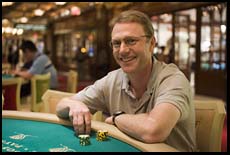
If you don't have or can't create a photo studio, concentrate onenvironmental portraiture. Show the subject and also his surroundings. These tend to work best if you can enlarge the final image to at least 11x14 inches. In any smaller photo, the subject's face is simply too small. Taking photos that will enlarge well is a whole art by itself. Your allies in this endeavor will be a low ISO setting, prime (rather than zoom) lenses, a tripod, and at least a mid-range digital SLR.
There are two elements to a photo studio for portrait photography. One is a controlled background. You want to focus attention on your subject and avoid distracting elements in the frame. Probably the best portraits aren't taken against a gray seamless paper roll. On the other hand, you are unlikely to screw up and leave something distracting in the frame if you confine yourself to using seamless paper or other monochromatic backgrounds. You don't have to build a special room to have a controlled background. There are all kinds of clever portable backdrops and backdrop supports that you can buy or build. If you absolutely cannot control the background, the standard way to cheat is to use a long fast lens, e.g., 300/2.8. Fast telephoto lenses have very little depth of field. Your subject's eyes and nose will be sharp. Everything else that might have been distracting will be blurred into blobs of color.

The second element of a portrait studio is controlled lighting. With lights on stands or hanging from the ceiling, you get to pick the angle at which light will strike your subject. With umbrellas and other diffusion equipment, you get to pick the harshness of the shadows on your subject (see out studio photography primer). There are some pretty reasonable portable flash kits consisting of a couple of lights, light stands, and umbrellas. These cost $500-1000 and take 20 minutes or so to set up on location. If you don't have the money, time, or muscles to bring a light package to a project, the standard way to cheat is to park your subject next to a large window and put a white reflecting card on the other side. Don't forget the tripod, because you'll probably be forced to use slow shutter speeds.
Stealing a Location
What if you don't have a big open space with diffuse light and a neutral background? Steal one. If you live in the United States, a vast open space with light pouring in from expensive skylights is as close as your nearest art museum or university. With a 200mm lens set to f/2.8, the background will be thrown out of focus. Here are some examples from the Boston Museum of Fine Arts and a couple of lobbies at MIT, taken on a cold February day in Boston. Canon EOS-5D, 70-200/2.8 IS lens, handheld without flash.
Lighting

The most flattering light for most portraits is soft and off-camera. A large north-facing window works, as does the electronic equivalent, the softbox (light bank). The Elsa Dorfman Polaroid photo at the top right was taken with two large light banks, one on either side of the camera. Note that there are essentially no shadows.
If your subject is outdoors, an overcast day is best. If the day is sunny, make sure to use a reflector or electronic flash to fill in shadows underneath the eyes.
At right: In a New York loft, light coming from a bank of windows at left. Canon 70-200/2.8 lens on tripod. Possibly some fill-flash. Fuji ISO 400 color negative film.
What if you're in Mexico, the sun is strong, the longest lens that you have is a 50/1.4, and you meet someone who needs a portrait for her Web page? The results will not be happy (left). On the other hand, if you're photographing people for whom bright mountain sun is their natural environment, the portrait can be acceptable (right; Olympus E1, 14-54/3.5 zoom at f/7.1 and 37mm (74mm equiv.)). |
 | The photo at left (Dieter) was taken with a Canon 35-350L zoom lens. The 35-350L slows down to around f/5.6 at longer focal lengths. The photo at right (Emma) was taken in Alaska'sKatmai National Park in front of a background with similar potential for distraction. Emma was captured on film with a 300/2.8 lens. You can decide for yourself whether the reduction in background distraction is worth the cost and weight of a fast lens. |  |
Julia Margaret Cameron
Julia Margaret Cameron
b. 1815 Calcutta, India, d. 1879 Sri Lanka
photographer
British
photographer
British
After receiving a camera as a gift, Julia Margaret Cameron began her career in photography at the age of forty-eight. She produced the majority of her work from her home at Freshwater on the Isle of Wight. By the coercive force of her eccentric personality, she enlisted everyone around her as models, from family members to domestic servants and local residents.
The wife of a retired jurist, Cameron moved in the highest circles of society in Victorian England. She photographed the intellectuals and leaders within her circle of family and friends, among them the portrait painter George Frederick Watts, the astronomer Sir John Herschel, and the Poet Laureate Alfred, Lord Tennyson. She derived much of her subject inspiration from literature, and her work in turn influenced writers. In addition to literature, she drew her subject matter from the paintings of Raphael, Giotto, and Michelangelo, whose works she knew through prints that circulated widely in late nineteenth-century England. Summing up her influences, Cameron stated her photographic mission thus: "My aspirations are to ennoble Photography and to secure for it the character and uses of High Art by combining the real and Ideal and sacrificing nothing of the Truth by all possible devotion to Poetry and beauty."
The wife of a retired jurist, Cameron moved in the highest circles of society in Victorian England. She photographed the intellectuals and leaders within her circle of family and friends, among them the portrait painter George Frederick Watts, the astronomer Sir John Herschel, and the Poet Laureate Alfred, Lord Tennyson. She derived much of her subject inspiration from literature, and her work in turn influenced writers. In addition to literature, she drew her subject matter from the paintings of Raphael, Giotto, and Michelangelo, whose works she knew through prints that circulated widely in late nineteenth-century England. Summing up her influences, Cameron stated her photographic mission thus: "My aspirations are to ennoble Photography and to secure for it the character and uses of High Art by combining the real and Ideal and sacrificing nothing of the Truth by all possible devotion to Poetry and beauty."
Information from http://www.getty.edu/art/gettyguide/artMakerDetails?maker=2026
The Surrounding area
Three Rivers Woodland park is situated in West Bradford, a beautiful little village amongst other beautiful towns and landscapes.
Heres a few pictures of West Bradford itself:
Heres a few of other surrounding areas:
Heres a few pictures of West Bradford itself:
Heres a few of other surrounding areas:
Cape Town Peninsular University of Technology.
The university we're visiting in Africa has a course similar to ours, and its going to be great to see some of their work and environment.
Hers a little about the university itself:

Here's a little about the ND photography course:
Costing approx. 12345 rand a year, which works out around £1100, which is just a little less than what we pay, although ours have now increased dramatically for future students.
Although the website doesn't give too much away on the course, here's the simple layout, which also looks similar to ours.
NATIONAL DIPLOMA: PHOTOGRAPHY
1. Course Aim
The course equips students with the skills, knowledge and discipline essential for a successful career in photography. Graduates are competent, self-motivated and creative, producing work with a strong emphasis on conceptual content and technical skills as appropriate to a particular professional context.
2. Career Opportunities
3. Admission Requirements
Download the CPUT Admission requirements prior to 2009.
Download the CPUT Admission requirements for 2010.
4. Programme Structure: (ND:)
Total number of subjects to obtain the National Diploma : 12
5. Offering Type and Duration of Course
Full-Time: Three years
6. Venues of Offering
Bellville
7. Contact details
Bellville
Contact: Mrs Anita America
Telephone: +27 +21 959 6356
Fax: +27 +21 959 6357
Email: americaa@cput.ac.za
Hers a little about the university itself:
About Us

In March 2001, the then-Minister of Education, Prof Kader Asmal, announced the National Plan on Higher Education which was set to change the higher education landscape of South Africa.
By 2006 the Cape Peninsula University of Technology had emerged fully from a protracted merger process, with six new faculties.
With the dust slowly settling on merger issues, it is becoming increasingly important to establish CPUT as one that pursues excellence in research, in striving to be at the heart of technology and innovation in Africa.
Becoming a University of Technology encompasses measuring research performance, and some of the key indicators of a university research environment are:
- the establishment of research niche areas and research units
- the number of peer-reviewed journal publications and conference papers produced by staff and postgraduate students
- the throughput and quality of postgraduate students
- income generated through scholarly grants and contract funding
- the registration of intellectual property in the form of patents
- the recognition of the research standing of staff, by peers at other higher education institutions and through NRF ratings
Research Report
The CPUT Research Report is published by the institution every two years.
- Click here to download the Research Report 2009
- Click here to download part 1 of the Research Report 2008
- Click here to download part 2 of the Research Report 2008
- Click here to download the Research Report 2007
Here's a little about the ND photography course:
Costing approx. 12345 rand a year, which works out around £1100, which is just a little less than what we pay, although ours have now increased dramatically for future students.
Although the website doesn't give too much away on the course, here's the simple layout, which also looks similar to ours.
NATIONAL DIPLOMA: PHOTOGRAPHY

1. Course Aim
The course equips students with the skills, knowledge and discipline essential for a successful career in photography. Graduates are competent, self-motivated and creative, producing work with a strong emphasis on conceptual content and technical skills as appropriate to a particular professional context.
2. Career Opportunities
- Commercial, advertising, fashion, publishing houses, printers and freelance work
- Employment opportunities also exist in state-supported institutions such as museums, library services and medical institutions
3. Admission Requirements
Download the CPUT Admission requirements prior to 2009.
Download the CPUT Admission requirements for 2010.
4. Programme Structure: (ND:)
Total number of subjects to obtain the National Diploma : 12
5. Offering Type and Duration of Course
6. Venues of Offering
7. Contact details
Bellville
Contact: Mrs Anita America
Telephone: +27 +21 959 6356
Fax: +27 +21 959 6357
Email: americaa@cput.ac.za
Subscribe to:
Posts (Atom)



